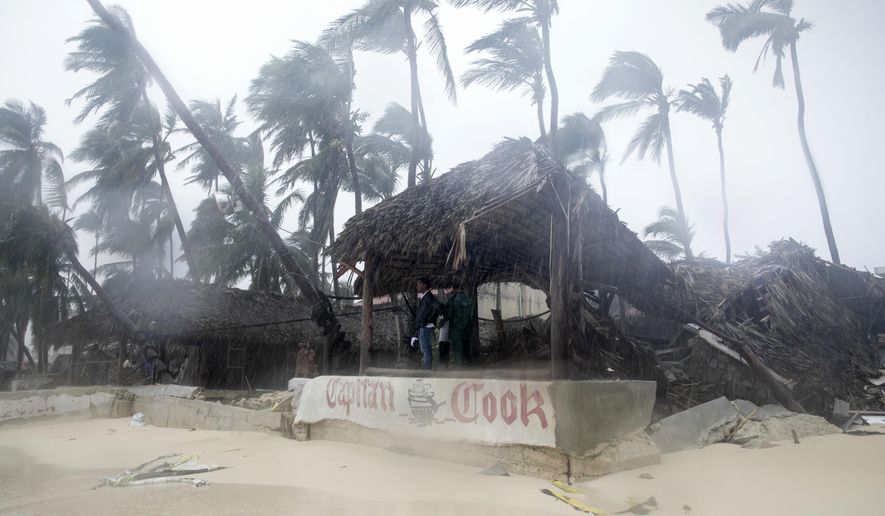Sparring with celebrities and Al Gore over global warming may not be what Roy Spencer had in mind when he earned his Ph.D., but it’s certainly become a bustling sideline for the University of Alabama in Huntsville climatologist.
A month after rebutting Mr. Gore’s documentary “An Inconvenient Sequel,” Mr. Spencer has published another short e-book, this one challenging statements by Jennifer Lawrence, Bill Nye, Stevie Wonder and others linking global warming to this year’s active hurricane season.
Called “Inevitable Disaster: Why Hurricanes Can’t Be Blamed on Global Warming,” the 50-page book was released Monday, and like his August e-book, “An Inconvenient Deception,” it’s already made landfall on the Amazon bestseller list.
As of midday Thursday, “An Inconvenient Deception” and “Inevitable Disaster” ranked number one and two on Amazon’s list of bestsellers in the category of Environment & Nature, while Mr. Gore’s companion book to “An Inconvenient Sequel” ranked 100th.
Mr. Spencer’s latest book challenges the oft-repeated assertion that this year’s powerful hurricane season is “what climate change looks like,” arguing that the storms are neither an aberration nor a result of rising carbon dioxide in the atmosphere.
“This isn’t what human-caused climate change looks like,” Mr. Spencer said in the e-book. “It’s what weather looks like.”
SEE ALSO: Puerto Rico faces weeks without electricity after Hurricane Maria
Hurricane Harvey and Irma became the first two Category 4 hurricanes to strike the U.S. coast on the Atlantic side in the same year, based on 166 years of record-keeping, prompting warnings from Mr. Gore, Pope Francis, Leonardo DiCaprio and others about human-caused climate change.
“This is an unusual time. Within the last two weeks, we have had two more record-breaking, climate-connected storms,” said Mr. Gore in a Monday speech at the World Economic Forum.
New York Gov. Andrew Cuomo weighed in at a Wednesday press conference, saying “we’ve had multiple Category 4 hurricanes come on land, more than ever before.”
A former NASA senior scientist for climate studies, Mr. Spencer said that having two hurricanes make landfall on the lower 48 within one year isn’t proof of climate change.
“There have been many years with multiple Cat 4 hurricanes in the Atlantic, but there is nothing about global warming theory that says more of those will make landfall,” Mr. Spencer said in an email. “While the official estimate is that this was the first time two Cat 4 storms hit the U.S., since Florida was virtually unpopulated before 1900, we probably don’t really know.”
Before this season, no Category 3 or larger hurricane had hit the U.S. coast since 2005 in what has been dubbed the “hurricane drought.”
In his speech, Mr. Gore said the record five-day rainfall from Hurricane Harvey constituted a “once-in-25,000-year event” and in some parts of Texas, a “once-in-500,000-year event.”
“We are departing the familiar bounds of history as we have known it since our civilization began,” Mr. Gore said. “And why? Because today like all days we will put another 110 million tons of man-made heat-trapping pollution into the atmosphere, using the sky as an open sewer.”
Those in the climate-change movement argue that while climate change doesn’t cause hurricanes, it makes them more intense, thanks in part to warmer sea temperatures.
“Often in the past these storms would churn up cold water from deeper down in the ocean and reduce the temperatures that drive the strength of these storms, but the heat went all the way down more than 200 meters to the bottom of the Gulf of Mexico, so it didn’t short-circuit,” Mr. Gore said. “It stayed. As many of the climate scientists are now pointed out, the melting of the Arctic is disrupting the northern hemisphere and storm track. You may remember the discussions last winter of polar vortex. It’s the same phenomena except it’s the summer.”
Mr. Spencer called the former vice president’s analysis “some sort of pseudo-meteorological gobbledygook.”
“What made Harvey rain totals exceptional was the system stalled next to the coast, which was due to a very temporary weakening of atmospheric steering currents,” said Mr. Spencer. “Virtually the whole month of August was below normal in temperature over most of the U.S., not what global warming theory predicts at all.”
He cited a graph of all major hurricane strikes in Florida since 1900 showing no increase in frequency or intensity as measured by wind speed. The worst hurricane on record to strike Florida was the 1935 Labor Day hurricane, one of only three storms on record to make U.S. landfall at Category 5.
If there is a trend, it’s that hurricanes seem to come in waves. The period from 1941 to 1961 was especially active for hurricanes making landfall, followed by a dip in the 1980s, then peaking again in 2004 and 2005.
Based on the frequency of Category 4 or higher hurricanes striking the continent since 1851, he said, “we should get two Cat 4+ strikes once every 50 years, on average,” which hasn’t happened in 150 years, meaning “we were overdue.”
Far more unusual is the 12-year hurricane drought, he said, which should occur based on probability once every 250-300 years, but so far nobody is attributing that fortunate happenstance to climate change.
“You can come up with all kinds of hurricane statistics which don’t mean much,” Mr. Spencer said. “Florida was hit by Cat 4 hurricanes four years in a row, in 1947, 1948, 1949, 1950. Then when Andrew hit in 1992, it had been 32 years since a Cat 4 hurricane had hit Florida. It doesn’t mean anything.”
• Valerie Richardson can be reached at vrichardson@washingtontimes.com.




Please read our comment policy before commenting.